 Bushbuck
Tragelaphus
scriptus
Bushbuck
Tragelaphus
scriptus Greater
Kudu Tragelaphus strepsiceros
Greater
Kudu Tragelaphus strepsiceros Nyala Tragelaphus angasi
Nyala Tragelaphus angasi
Lonely Planet's Watching Wildlife in East Africa (Andrew
& Rhind 2001) call them "the Magnificent Seven." There are actually
nine species in Spiral-horned Antelope tribe [Strepciserotini]
but only seven are in East Africa. The others occur farther north or west.
But the seven species in the genus Tragelaphus can, indeed, be thought
of as the Magnificent Seven. These are the large and elusive antelope characterized
by outrageously impressive spiraled horns in the males, and lovely camouflaged
patterns in the females. In this genus only the males have horns; in the
two species of eland (genus Taurotragus) both sexes are horned.
The eland are not as glamorous as the spiral-horned specialties -- they
are more like wild cattle and range in open country -- but they also belong
to this tribe.
Dioramas of some of the Magnificent Seven had quite an impression on me as a youngster. These are the life-like displays at the American Museum in New York (with some of the antelope shot by Theodore Roosevelt on his post-Presidency African safari) and at the California Academy of Sciences in San Francisco. Those at the latter site had backgrounds painted to match specific spots that harbor the wild antelopes now stuffed and mounted in the foreground. There was a Lesser Kudu with a backdrop of arid northern Kenya or a Bongo emerging from bamboo thickets deep in the dark Congolese forest. I've wanted to see these ever since. Here's a list of the "Magnificent Seven;" to date I've seen only three (with headnote photos). More on them follows below.
 Bushbuck
Tragelaphus
scriptus
Bushbuck
Tragelaphus
scriptus Greater
Kudu Tragelaphus strepsiceros
Greater
Kudu Tragelaphus strepsiceros Nyala Tragelaphus angasi
Nyala Tragelaphus angasi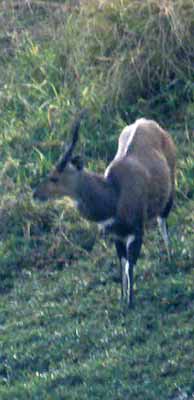

Bushbucks are found mostly singly or in small groups, but seem always to be shy and alert. They communicate by dog-like barks (as do others in this genus) but are primarily nocturnal. Fortunately they are common and they range across all of sub-Saharan Africa.
Those species I have not yet observed are much more local, and some
are quite scarce. The near mythical Bongo
lives in the deepest thickets (particular bamboo) in the Congo Basin; a
few isolated populations are in dense montane forests in east Africa. It
is exceptionally shy and rarely seen. The Sitatunga
is an aquatic antelope specializing primarily on papyrus swamps and reedbeds
in central Africa. It is also shy and seen, if at all, only early or late
in the day. When alarmed it completely submerges with only the nostrils
above water. In contrast, the Lesser Kudo
is an elegant antelope of arid and rocky scrub habitats in east Africa.
The Gedemsa (sometimes called "Mountain Nyala")
is a large antelope restricted to the Arusi and Bale Mountains of Ethiopia
where in inhabits highland forests and heathland, and superficially recalls
Greater Kudo.
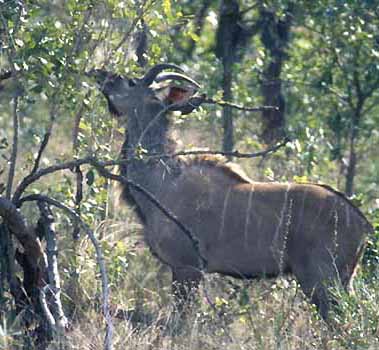
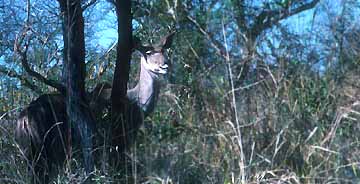
The Greater Kudu is the largest of the seven Tragelaphus
(although the closely related Gedemsa of Ethiopia is virtually the same
size). It has a widespread but patchy range in east, central, and southern
Africa. It is primarily an antelope of hilly deciduous woodland, as in
these shots of a female (above) and a young male (right)
in Kruger Nat'l Park, South Africa. It the dry season it retreats to watercourses
or foggy highlands but ranges more widely throughout the woods in the wet.
They particularly like stony hill country and can survive without water
if the browse is sufficient succulent. With their large size and long necks,
they can reach higher foliage than any ungulate except giraffes.
The young male shown in my photo has quite short horns. I have yet to see the magnificent sets carried by fully adult males. Despite the impressive spiraled horns of adult males they rarely fight. Rather, dominance is shown in all this group by posturing. Males also have fine manes and fringes of hair; this male's pattern is coming in nicely.
Greater Kudos are found most in small herds although large males often separate into unisex groups or are solitary. During the mating season (in the dry season), males gather and posture in ruts, and dominant males have dry-season territories. Groups of females, usually with youngsters, wander within this territory.
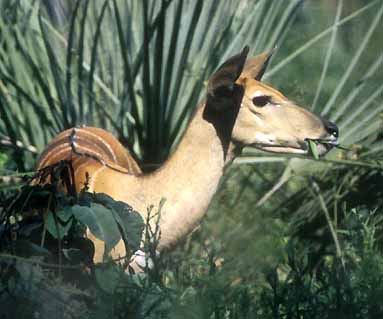 The lovely Nyala (female left) has a patchy and restricted
range in southeastern Africa. It is found in riverine thickets along watercourses;
all the shots here are from the Limpopo River vicinity of Kruger Nat'l
Park in South Africa, right near the border with Mozambique. In fresh growth,
Nyalas can gather in herds of up to fifty animals. It usually takes 3 years
for a male to become fully adult with developed crests and tassles.
The lovely Nyala (female left) has a patchy and restricted
range in southeastern Africa. It is found in riverine thickets along watercourses;
all the shots here are from the Limpopo River vicinity of Kruger Nat'l
Park in South Africa, right near the border with Mozambique. In fresh growth,
Nyalas can gather in herds of up to fifty animals. It usually takes 3 years
for a male to become fully adult with developed crests and tassles.
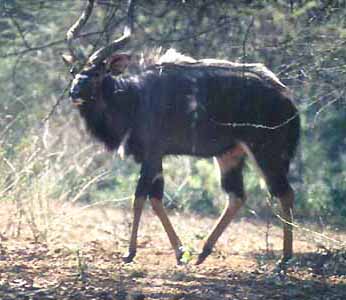 The
male
Nyala (right) has the most extreme advertising visuals of all this
group. Strutting displays generally result in the subordinate male lowering
its head and crest as he withdraws. Rare fights with horns can cause serious
wounding or death. We didn't see many adult males during our visit but,
when seen, they are certainly impressive.
The
male
Nyala (right) has the most extreme advertising visuals of all this
group. Strutting displays generally result in the subordinate male lowering
its head and crest as he withdraws. Rare fights with horns can cause serious
wounding or death. We didn't see many adult males during our visit but,
when seen, they are certainly impressive.
In Kruger Nat'l Park one could "feel" the difference when you drove
into the habitat of these impressive antelope. As one dropped from the
hot, dry plateaus and plains into the river valley the air became cool
and muggy. I can just feel and smell that habitat in this habitat shot
(below) with a female Nyala. Her beautiful coat of chestnut with white
vertical stripes seems a perfect fit for the dense woodland.
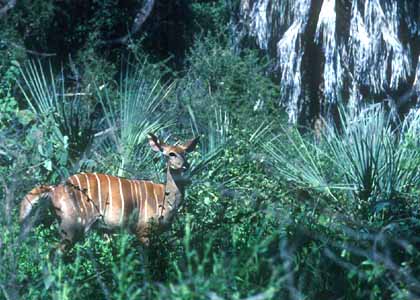
Finally, there are two species of eland. The Common Eland Taurotragus
oryx (both photos below; the one on right by Ed Harper) is widespread
in the grasslands of east and southern Africa. The Giant (or Derby's) Eland
T. derbianus is more of a woodland species in the broken dry woods south
of the Sahara in west and central Africa.
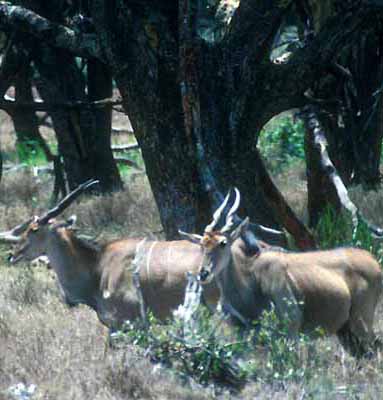
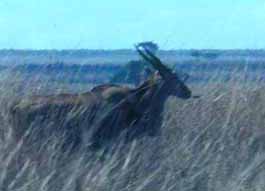
Both sexes of Common Eland have horns unlike the other antelope in
this tribe. This is presumably because they are an open grassland species
and thick straight horns help to deter predators. Eland are gregarious
and often occur in small herds, but these herds are nomadic. They range
widely throughout the habitat and can thus be unpredictable day-to-day.
Both species of eland have cow-like bodies, heavy dewlaps, and tufted tails.
Males can grow very large and heavy, and there is a hierarchy based on
size.
The taxonomy here generally follows Macdonald, D., ed. (1984) The Encyclopedia of Mammals, 1st ed. Facts on File Publ., New York. Other than personal experiences, the facts are mostly summarized from that text or from Williams (1967) or Kingdon (1997). Citations:
Andrew, D., and S. Rhind. 2001. Watching Wildlife in East Africa. Lonely Planet, Oakland, CAPHOTOS: All photos on this page are © 2001 Don Roberson except that attribtued to © W. Ed Harper 2001, and used with permission; all rights reserved. The female Bushbuck was photographed at Mountain Lodge on Mt. Kenya, Kenya, in Nov 1981; the male was in Kruger Nat'l Park, South Africa, in July 1996. The Greater Kudu and the Nyala were also photographed in Kruger in July 1996. My distant Common Eland was in Nairobi Nat'l Park in Nov 1981; W. Ed Harper photographed his eland herd in Tanzania in July 1996.Kingdon, J. 1997. The Kingdon Guide to African Mammals. Academic Press, London
Williams, J. G. 1967. A Field Guide to the National Parks of East Africa. Collins, London.